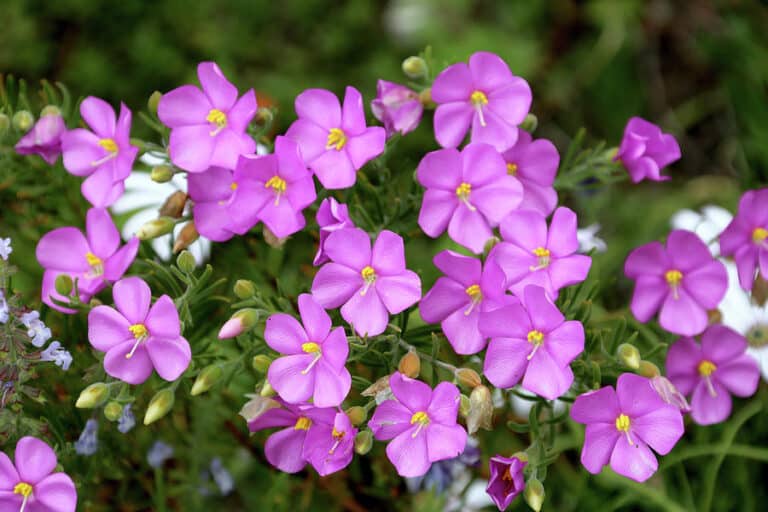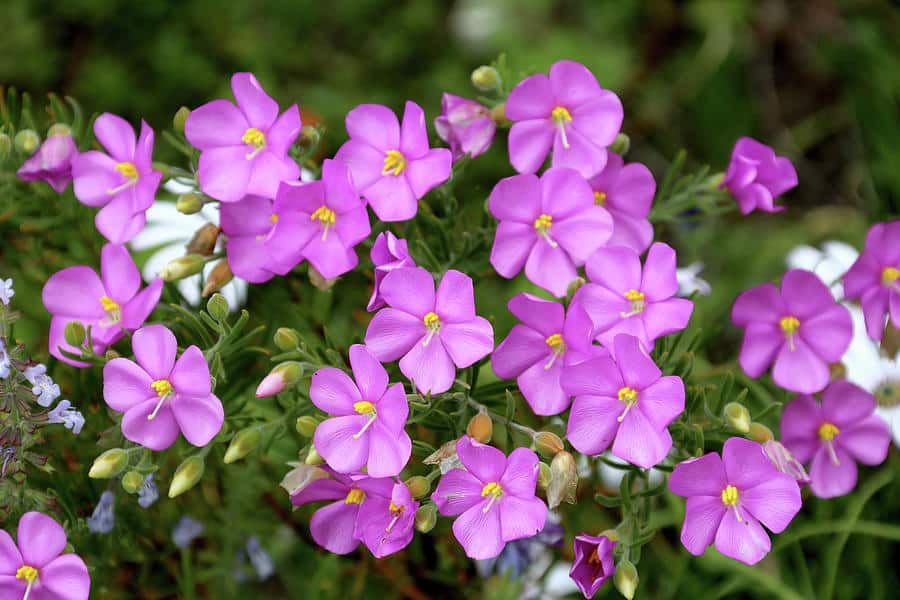Table of Contents
Introduction
Aubrieta (Aubretia), also known as false rock cress, is a delightful perennial plant appreciated for its cascading mats of vibrant flowers. Belonging to the Aubrieta genus, this low-growing plant is cherished for its ability to blanket walls, rockeries, and pathways with a profusion of blooms, particularly during the spring months. Its charming purple, pink, blue, or white blossoms create a stunning visual display, attracting pollinators and admirers alike. Aubrieta is easy to grow, requiring little maintenance once established, making it a favorite choice for gardeners seeking to add a splash of color and beauty to their landscapes.
Exploring 5 Varieties of Aubrieta Plants
There are several varieties of Aubrieta plants, each offering its own unique charm and characteristics:
Aubrieta deltoidea: This is the most common species, known for its vigorous growth and abundance of purple flowers.
Aubrieta cultorum: Cultivated varieties of Aubrieta often feature a wider range of colors, including shades of pink, blue, and white.
Aubrieta ‘Cascade Blue’: This variety is prized for its intense blue flowers and trailing habit, perfect for cascading over walls and containers.
Aubrieta ‘Royal Red’: With its striking deep red flowers, this variety adds a bold pop of color to any garden.
Aubrieta ‘Dr. Mules Variegata’: This cultivar stands out with its variegated foliage, adding visual interest even when not in bloom.
Aubrieta ‘Audrey Blue’: Known for its compact size and prolific flowering, this variety is ideal for small spaces or rock gardens.
Regardless of the variety, all Aubrieta plants are valued for their ability to create stunning carpets of flowers and bring joy to any garden setting.
How to Grow and Care for Aubrieta Plant
Growing and caring for Aubrieta plants is relatively straightforward, and here are some essential tips to ensure their success:
Location: Choose a well-draining location with full sun to partial shade. Aubrieta prefers slightly alkaline soil but will adapt to various soil types.
Planting: Plant Aubrieta in the spring or early summer. Space them about 6 to 12 inches apart, depending on the variety, as they will spread quickly.
Soil: Ensure the soil is well-draining and fertile. If the soil is too heavy, amend it with compost or sand to improve drainage.
Watering: Water newly planted Aubrieta regularly to establish roots. Once established, they are drought-tolerant and only need watering during prolonged dry spells.
Fertilizing: Aubrieta doesn’t require much fertilization. A light application of balanced fertilizer in the spring can promote healthy growth and flowering.
Pruning: After flowering, trim back the spent blooms to encourage a second flush of flowers and maintain a compact, tidy appearance.
Winter Care: Aubrieta is generally hardy and can withstand frost, but providing a layer of mulch around the plants can help protect them during harsh winters.
Propagation: Propagate Aubrieta by taking softwood cuttings in late spring or early summer. Root them in a well-draining medium and keep them moist until established.
By following these simple guidelines, you can enjoy the beauty of Aubrieta plants as they cascade with colorful blooms and enhance your garden landscape.

8 Steps for Propagating Aubrieta Plant
Propagating Aubrieta plants can be done through softwood cuttings in late spring or early summer. Here are the steps to propagate Aubrieta:
Preparation: Start by selecting a healthy, established Aubrieta plant from which to take cuttings. Choose non-flowering stems that are soft and flexible.
Cutting Selection: Using clean and sharp pruning shears, cut a 4 to 6-inch section of a stem just below a leaf node. Ensure the cutting has at least one set of leaves and remove any lower leaves to expose the node where roots will form.
Preparation of Cuttings: Dip the cut end of the stem in rooting hormone powder to promote root growth. While this step is optional, it can enhance the success rate of rooting.
Planting: Prepare a well-draining rooting medium such as perlite, vermiculite, or a mixture of peat and sand. Plant the cuttings in the medium, ensuring that at least one node is buried beneath the surface.
Moisture and Environment: Place the cuttings in a warm, bright location with indirect sunlight. Keep the rooting medium consistently moist but not waterlogged. To maintain humidity, you can cover the cuttings with a clear plastic dome or place them in a plastic bag with ventilation holes.
Root Development: Over the next few weeks, monitor the cuttings for signs of root development. Gently tug on the stem to check for resistance, indicating the presence of roots.
Transplanting: Once the cuttings have developed a healthy root system, typically after 4 to 6 weeks, they can be transplanted into individual pots or directly into the garden. Be gentle when handling the delicate roots.
Care: Provide the newly transplanted Aubrieta with appropriate care, including regular watering to keep the soil moist until they become established.
By following these steps, you can successfully propagate Aubrieta plants and expand your garden with these charming and colorful perennials.
8 Benefits of Aubrieta Plant
Aubrieta plants offer several benefits beyond their aesthetic appeal:
Erosion Control: With their dense, spreading growth habit, Aubrieta plants are excellent for stabilizing soil on slopes and preventing erosion.
Pollinator Attraction: The colorful flowers of Aubrieta attract bees, butterflies, and other pollinators, contributing to the health and diversity of the ecosystem.
Low Maintenance: Once established, Aubrieta requires minimal care, making it an ideal choice for busy gardeners or low-maintenance landscapes.
Ground Cover: Aubrieta forms a dense mat of foliage that effectively suppresses weeds, reducing the need for herbicides and manual weeding.
Versatility: Whether cascading over walls, edging pathways, or filling in gaps in rock gardens, Aubrieta adapts well to various garden settings and adds visual interest.
Long Blooming Period: Aubrieta produces an abundance of flowers over an extended period, typically from early spring to early summer, providing continuous color in the garden.
Cold Hardy: Aubrieta is cold-hardy and can withstand frost, making it suitable for gardens in colder climates.
Adaptability: Aubrieta is tolerant of a wide range of soil types and environmental conditions, including drought once established, making it versatile in different garden situations.
Overall, Aubrieta plants offer both practical and aesthetic benefits, making them a valuable addition to any garden landscape.
Common Pests
While Aubrieta plants are generally resilient, they may occasionally encounter pests. Some common pests that may affect Aubrieta include:
Aphids: These small, soft-bodied insects feed on the sap of plants, causing distorted growth and yellowing leaves. They can be controlled with insecticidal soap or neem oil.
Slugs and Snails: These mollusks feed on the leaves and flowers of Aubrieta, leaving behind slimy trails. They can be deterred with barriers, such as copper tape, or controlled with slug pellets.
Cabbage Worms: The larvae of cabbage white butterflies, cabbage worms, can chew holes in the leaves of Aubrieta. Handpicking the caterpillars or using biological controls like Bacillus thuringiensis (Bt) can help manage infestations.
Spider Mites: These tiny pests feed on the undersides of leaves, causing stippling and webbing. Spraying plants with water or using insecticidal soap can help control spider mite populations.
Leaf Miners: The larvae of certain flies, leaf miners, tunnel through the leaves, leaving distinctive trails. Pruning affected foliage and disposing of infested leaves can help manage leaf miner infestations.
Wireworms: The larvae of click beetles, wireworms, feed on the roots of plants, causing stunted growth and wilting. Avoid planting Aubrieta in areas where wireworms are known to be present.
Regular monitoring and early intervention are key to managing pest infestations on Aubrieta plants. Additionally, promoting biodiversity in the garden can attract natural predators that help keep pest populations in check.
Common Problems
While Aubrieta is a relatively hardy plant, it can sometimes encounter issues that affect its health and appearance. Some common problems that Aubrieta may face include:
Overwatering: Aubrieta is susceptible to root rot if the soil remains consistently soggy. Ensure that the soil has good drainage and water only when the top inch of soil feels dry to the touch.
Underwatering: Conversely, underwatering can lead to wilting and poor growth. Monitor soil moisture levels, especially during hot and dry periods, and water as needed to keep the soil evenly moist.
Poor Soil Conditions: Aubrieta prefers well-draining, slightly alkaline soil. Soil that is too compacted or lacks adequate drainage can lead to issues such as root rot or stunted growth. Amend the soil with organic matter to improve its structure and fertility.
Fungal Diseases: Aubrieta plants may be susceptible to fungal diseases such as powdery mildew or leaf spot, especially in humid conditions. Provide good air circulation around plants, avoid overhead watering, and remove and dispose of affected foliage to prevent the spread of disease.
Pests: As mentioned earlier, pests such as aphids, slugs, and snails can occasionally feed on Aubrieta foliage, leading to damage and reduced plant vigor. Monitor plants regularly for signs of pest infestations and take appropriate measures to control them.
Winter Damage: In areas with harsh winters, Aubrieta plants may suffer damage from freezing temperatures or frost. Provide winter protection by applying a layer of mulch around the base of plants or covering them with a frost cloth during cold spells.
Lack of Flowering: Insufficient sunlight or nutrient deficiencies can inhibit flowering in Aubrieta plants. Ensure plants receive adequate sunlight (at least 6 hours of direct sun per day) and fertilize them lightly in the spring with a balanced fertilizer to promote blooming.
By addressing these common problems promptly and providing proper care, you can help ensure the health and vitality of your Aubrieta plants.
FAQs
How often should I water Aubrieta?
Water Aubrieta plants regularly, especially during dry spells, but avoid overwatering. Allow the top inch of soil to dry out between waterings to prevent root rot.When is the best time to plant Aubrieta?
The best time to plant Aubrieta is in the spring or early summer, after the threat of frost has passed. This allows the plants to establish themselves before the heat of summer.How do I deadhead Aubrieta?
Deadheading involves removing spent flowers to encourage continuous blooming. Simply pinch off the faded flowers at the base of the stem with your fingers or use pruners.Can I grow Aubrieta from seed?
Yes, Aubrieta can be grown from seed. Sow the seeds indoors in early spring or outdoors in late spring. Keep the soil moist until the seeds germinate, and transplant seedlings once they are large enough to handle.How can I encourage Aubrieta to bloom more?
To encourage more blooms, provide Aubrieta with full sun and well-draining soil. Avoid over-fertilizing, as this can lead to excessive foliage growth at the expense of flowers. Deadhead regularly to promote continuous blooming.Is Aubrieta deer-resistant?
Aubrieta is generally considered deer-resistant due to its low palatability. However, hungry deer may still nibble on the foliage during times of food scarcity.How do I propagate Aubrieta?
Aubrieta can be propagated through softwood cuttings taken in late spring or early summer. Dip the cuttings in rooting hormone and plant them in a well-draining rooting medium. Keep the cuttings moist until they develop roots.Does Aubrieta require pruning?
While Aubrieta doesn’t require extensive pruning, you can trim back the plant after flowering to maintain its shape and encourage a second flush of blooms. Avoid cutting into old wood, as this can damage the plant.
Share this post:




